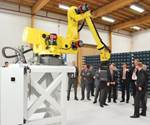Marquez innovates aircraft TPCs
Marquez (Montréal, Québec, Canada) supplies TPC ducting for The Boeing Co.’s 787 Personal System Unit (PSU), and the TPC structural window bezel used on all Bombardier (Montréal, Canada) Global Express business aircraft.
Repeatedly recognized for its innovative design and manufacturing, Marquez (Montréal, Québec, Canada) has produced advanced thermoplastic composite structures since 1996. Currently, the company supplies TPC ducting for The Boeing Co.’s 787 Personal System Unit (PSU), and the TPC structural window bezel used on all Bombardier (Montréal, Canada) Global Express business aircraft (photo at right).
The PSU delivers fresh air to each passenger via ductwork, through overhead nozzles. Marquez supplies 60 different parts for the 787 PSU ductwork, delivering a part every six minutes. About 90 percent of the structure is polyetherimide (PEI) reinforced with continuous S-2 Glass fiber (supplied by AGY Holdings Inc., Aiken, S.C.) and 10 percent unreinforced for the connection areas at each part’s end. Most of the parts are 48 inches/1.2m long. Many have complex geometries because the ductwork twists and turns as it moves air through the crowded overhead space.
Once a retrofit, the TPC window bezel now is standard on all Global Express aircraft. The 11.8-inch (298.5-mm) by 17.4-inch (441.3-mm) by 1.2-inch (30.5-mm) thick frame is the structural bone of the seven-piece window assembly, and was codeveloped with Fiberforge (Glenwood Springs, Colo.), which produces the part for Marquez. According to Martin Levesque, Marquez director of R&D, “The bezel is unusual as a structure in that it is empty in the middle, so Fiberforge was able to work with us to develop a donut-shaped blank, as there would have been too much waste to form it from a solid one.” He adds that the Fiberforge process is well-suited for applications that require a customized TPC blank. The companies worked together for a year to develop the specialized bidirectional laminate sequence which uses 19 plies of unidirectional S-2 Glass-reinforced polyphenylene sulfide (PPS) to achieve tightly limited deflection in two directions. This enables the bezel to form a hermetic (airtight) seal, which not only maintains cabin pressure but also prevents window fogging. “Our design accommodates the fuselage movement while maintaining the seal so that the temperature and humidity between the outer and inner windows in controlled and no fogging occurs,” says Levesque, noting that the PPS matrix works well because it can deflect in one direction but remain rigid in the other and is ductile enough to prevent cracking. Originally, Marquez vacuum-assisted resin transfer molded a thermoset composite prototype. However, during testing that simulated 1,500 take-off and landing cycles with temperatures between -55˚C to 85˚C (-67˚F to 185˚F), the part started cracking. The test result prompted a trial with S-2 Glass/PPS tape prepregged by Ten Cate Advanced Composites (Nijverdal, The Netherlands). The tape, widely used for automated tape layed aerospace structures, thus provided the least costly material option.
Related Content
-
PEEK vs. PEKK vs. PAEK and continuous compression molding
Suppliers of thermoplastics and carbon fiber chime in regarding PEEK vs. PEKK, and now PAEK, as well as in-situ consolidation — the supply chain for thermoplastic tape composites continues to evolve.
-
Combining multifunctional thermoplastic composites, additive manufacturing for next-gen airframe structures
The DOMMINIO project combines AFP with 3D printed gyroid cores, embedded SHM sensors and smart materials for induction-driven disassembly of parts at end of life.
-
The lessons behind OceanGate
Carbon fiber composites faced much criticism in the wake of the OceanGate submersible accident. CW’s publisher Jeff Sloan explains that it’s not that simple.













